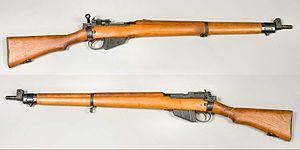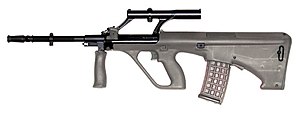Service rifles of Meridon
This is a list of service rifles used by the Meridon Defense Forces.
Pre-1900s
1900-1941
Type 1906 Army
Great War
F4 Autoloading Rifle
Upon its entry to the Great War in 1941, most Meridonian infantrymen were primarily armed with the 1898 Briggs Navy rifle, with variants chambered both in .30-40 and newer 7.6x5mm, with the Navy and Regiment Marines Commando primarily using the former and the Army the latter. Facing off against forces that were armed with more modern semiautomatic rifles, the Army and Navy joint design groups agreed to compromise- accepting the Navy's desire for a semiautomatic rifle, utilizing the Army's newer 7.6x5mm caliber. What resulted was the Type 4, later redesignated as the F4, a semi-automatic rifle fed by a 10-round en bloc clip. This rifle was first introduced in early 1940 to Army units, and by 1941 became a standard across frontline units in the Meridonian Army. The rifle was simple to maintain and served as a staple in the Army for the entirety of the Great War and the greater half of the 20th century, including utilization as a marskman rifle and ceremonial weapon until its retirement in those roles in 1970.
Harrington F48 Infantry Battle Rifle
In an effort to provide the infantry squad with greater automatic firepower and consolidate the amount of issued weapons systems, in 1948 a competition was held in order to create a service weapon to eventually phase out the F4 Semiautomatic Rifle. Requirements for the weapons system were that it be chambered for the F4's standard 7.6x5mm and be capable of accepting 10-round stripper clips as well as being fed from a detachable magazine, that it was capable of semi and fully-automatic fire, and that it possessed an adjustable gas port system. Accepted into service in 1949, the Infantry Battle Rifle (IBR) was put into service with Marine Commando units in Hiakemiria by the end of the year, but due to the bombing of Fuzan and the subsequent collapse of the front the rifles only saw limited combat service during the Great War. While their performance as battle rifles were admirable and troops loved the simplicity of use and maintenance, most models handled fully-automatic fire poorly, a development which lead to the deemphasis of a universal rifle for infantry squads and the employment of light support weapons as a standard facet of Meridonian doctrine.
The F48 has served one of the longest service periods of any Meridonian service rifle, remaining in use in limited roles to this day.
Post-Great War
Merson F56 Squad Rifle System
In the mid 1960s, an initiative was lead to replace the F48 IBR as a service weapon with a lighter, more modular firearm firing an intermediate cartridge, allowing infantrymen to take advantage of automatic fire with service weapons and enabling a more maneuverable weapon for close quarters combat and operations in austere terrain by reducing the weight of ammunition necessary to be carried. Development trials resulted in the procurement of both 5.56x45mm ammunition and the Merson F56 rifle system, which was intended to replace all rifle squad weapons with a common weapon in a similar vein to the F48's initial goal. The F56 was also cheaper to manufacture than the F48 owing to its usage of stamped receiver parts. First issued in 1964, it replaced F48s as the primary service rifle by 1968 but remained unpopular as a stand-in for light support weapons, due to the unreliability of the extended magazines. This would prove to be a nail in the coffin for squad-level weapon commonality. As a rifle, however, it performed admirably and proved popular after initial teething issues. It also performed well on the civilian market and remains one of the most popular models of semiautomatic firearms sold in Meridon to this day. The F56 has been mostly replaced by the F72 in most frontline roles, but remains in use as a designated marksman rifle in its 7.6x5mm chambered variants, as a weapon for special forces and certain rear-echelon troops, and in some cases as a ceremonial weapon.
Modern
F72 Infantry Rifle System
The F72 Infantry Rifle System, produced by Merson, was produced as part of a sweeping 'Millenium Reform' package for the Meridonian Army, itself part of President Franklin Tulin's military reforms and upgrades of the 1990s. Its design was unconventional and initially controversial- feeding from the same DSMS 30 round magazine and 5.56x45mm ammunition, it was designed as a compact, bullpup-operated and highly modular rifle. Although it was smaller, more modern, and came with an integral scope, it offered relatively little performancewise over its serving contemporary in the F56. However, it proved immensely popular with infantrymen, who found operating and maintaining the rifle to be simple and carrying the weapon to be much easier than the F56 once muscle memory was overcome. The F72 was adapted into a submachine gun in the F73C and abortively into a DMR and LSW in the F74H. The F72 has received several upgrades over its service life, with F72A3 variants introduced in the late 2010s serving as the current primary service weapon of the Meridon Defense Forces.





